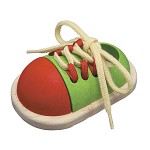How To Teach Kids To Tie Shoes ?
 While a child is growing up, with every passing day parents have to face a new challenge training the child for a new thing. One of the challenges faced by the parents is teaching the child to tie shoes. The child will, on his own try different ways to tie the laces like rolling them or stuffing them in the shoes to make them tight, but learning actual tying is a challenge and comes with age.
While a child is growing up, with every passing day parents have to face a new challenge training the child for a new thing. One of the challenges faced by the parents is teaching the child to tie shoes. The child will, on his own try different ways to tie the laces like rolling them or stuffing them in the shoes to make them tight, but learning actual tying is a challenge and comes with age.
When you feel that the child is ready to learn something unusual or which is not the routine, this is time to teach the child. This normally is when the child is around five years of age. It is found that girls tend to mature faster and start learning things earlier as compared to boys.
The first signal of his being ready to experiment with clothes and shoes will be when he will try to put on socks and put the feet in shoes. Take this opportunity to start training and assist the child as much as possible, do not ignore. If the child is trying again and again and is unable to do it, it will lead to frustration and the learning process may become somewhat difficult. Make the child try again and again without bothering for the time being taken to learn.
After the child learns to put on the socks on his or her own it is time to explain the difference between left and right shoe. In the initial period the child will find difficult to distinguish but discomfort of putting wrong feet in a shoe will make the child learn. Once the child understands this, move on to teaching how to tie shoes.
There can be no particular way of teaching. Parents can try teaching with some nursery rhyme or song. One of the ways to teach can be is to have spare laces. Make the child sit with you at a table and learn to tie both ends of the spare laces. Once he is able to do it, try with shoes. While you tie the laces of the child ensure that he or she looks to the process attentively. As far as possible involve him in the process and you will find slowly the child will pick up. This is good training which will help development of the child.